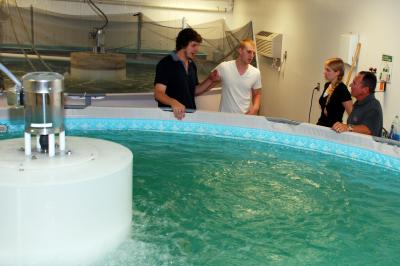NMSU researchers combine algae, cotton to grow shrimp in New Mexico

"If you want to have fresh shrimp in New Mexico, why not grow it here if you can," said Wiebke Boeing, an associate professor in NMSU's Department of Fish, Wildlife and Conservation Ecology. She specializes in aquatic ecology and is heading up the study sponsored by Cotton Inc. and the National Alliance for Advanced Biofuels and Bio-Products.
Boeing said the economic development impact of a shrimp industry in the state could be significant. Earlier this year, she visited shrimp farms in Michigan where shrimp farmers have trouble keeping up with demand. She said the same could happen in New Mexico.
Right now, the biggest expenses for shrimp farmers around the country include the price of commercial feed and the cost of electricity needed to keep the water in shrimp tanks at the appropriate temperature. While New Mexico's climate could easily solve the cost of heating, Boeing's research is aimed at solving the price of feed.
She said previous research has shown glandless cottonseed meal can replace a portion of fishmeal, as long as fish oil is supplemented into the feed. Boeing believes a shrimp diet that replaces the remaining fish products with marine algae should be cheaper and more sustainable, and therefore attract the attention of shrimp farmers.
Over the next year, she'll develop shrimp feed with varying mixtures of glandless cottonseed meal and algae. From there, she'll measure the survival and food conversion ratio of shrimp grown in aquariums using five different feed mixtures. Pacific White Shrimp will be used for the experiments. The algae used will be grown at the Solix photobioreactor at NMSU's Leyendecker Plant Science Center.
"In the end, it all comes down to sustainability," she said. "With a growing human population, we have to think more and more about ways to eliminate waste. If an algae industry for making biodiesel takes off, New Mexico could become a hot spot. Using algae in shrimp farming would complement the biodiesel industry."


